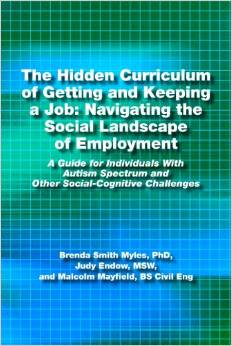CHAPTER FOUR
THE HIDDEN CURRICULUM BEYOND THE JOB MATCH
The job match is considered crucial for successful employment of anybody, but especially so for adults with social-cognitive challenges, including those with autism spectrum disorders (ASD), who tend to thrive in jobs whose requirements match their personal strengths and preferences (Schutte, 2009).
Grandin and Duffy (2008) identified jobs that are compatible with the learning style of visual thinkers and nonvisual thinkers. They have also identified vocations that are less suitable (see Table 4.1).
Researchers Howlin, Alcock, and Burkin (2005) attempted to quantify the concept of job matching for adults with high-functioning autism spectrum disorders (HFASD) by identifying the types of work held by 89 adults with HFASD. Table 4.2 highlights the type of work, examples of jobs within each type, and the percentage of adults who held this type of position.
Many of these jobs have structure, routine, and focus on a special interest, all crucial attributes when finding suitable employment for individuals with ASD (Hagner & Cooney, 2005). Researchers and practitioners further assert that adults with HFA are successful in jobs that require few or very structured social interactions. For example, jobs that incorporate mentors (see Chapter Two) who clearly specify job responsibilities, expectations, assumptions, and rules provide the predictability necessary for employees on the spectrum. Table 4.3 lists a series of factors that create employment success (Dew & Alan, 2007; Hagner & Cooney, 2005; Hurlbutt & Chalmers, 2004).
Table 4.3
Factors That Lead to Successful Employment for Adults on the Spectrum
• Consistent schedule and job responsibilities
• Ongoing relationship with a mentor, who explains specific job duties,
responsibilities, expectations, and rules related to productivity,
breaks, tasks, social interactions, and how to ask for help
• Predictable social demands
• System to keep track of work progress
• Predictable routines for lunch, breaks, and other unstructured times
during the workday
• Time before the beginning of the workday to organize self and tasks
• Direct communication with opportunities for clarification and
verification
• Reminders and reassurances
• Coworkers who initiate interactions and help “keep an eye out”
for the employee
• If support providers are involved, a method to transfer these
services and supports to the mentor and fellow employees
Adults with classic autism and with HFASD rank the lowest among all disability groups in employment, with 6% and 12%, respectively, having jobs (http://www.autism.org.uk/living-with-autism/employment.aspx). This, combined with the short job tenure of high-functioning adults on the autism spectrum, makes it clear that the concept of job matching must be broadened to take into consideration the hidden curriculum beyond the job match. That is, the traditional notion of job matching is only one component since many adults can easily master the job task itself. Among those who get hired, many find that the work environment, along with all the complex everyday situations generated by the various players, tips the scales in such a way as to become the deal breaker in terms of keeping the job.
In this chapter, we will look at elements of the work-related hidden curriculum that are known to pose challenges for individuals with autism and other social-cognitive difficulties who otherwise meet the specific “technical” requirements of a given job. These include (a) arriving at work ready to engage, (b) managing stress to maintain engagement throughout the workday, and (c) interpreting and reacting to social demands.
Excerpt from The Hidden Curriculum of Getting and Keeping a Job: Navigating the Social Landscape of Employment, pp. 45-49.
BOOKS BY JUDY ENDOW
Endow, J. (2019). Autistically Thriving: Reading Comprehension, Conversational Engagement, and Living a Self-Determined Life Based on Autistic Neurology. Lancaster, PA: Judy Endow.
Endow, J. (2012). Learning the Hidden Curriculum: The Odyssey of One Autistic Adult. Shawnee Mission, KS: AAPC Publishing.
Endow, J. (2006). Making Lemonade: Hints for Autism’s Helpers. Cambridge, WI: CBR Press.
Endow, J. (2013). Painted Words: Aspects of Autism Translated. Cambridge, WI: CBR Press.
Endow, J. (2009). Paper Words: Discovering and Living With My Autism. Shawnee Mission, KS: AAPC Publishing.
Endow, J. (2009). Outsmarting Explosive Behavior: A Visual System of Support and Intervention for Individuals With Autism Spectrum Disorders. Shawnee Mission, KS: AAPC Publishing.
Endow, J. (2010). Practical Solutions for Stabilizing Students With Classic Autism to Be Ready to Learn: Getting to Go. Shawnee Mission, KS: AAPC Publishing.
Myles, B. S., Endow, J., & Mayfield, M. (2013). The Hidden Curriculum of Getting and Keeping a Job: Navigating the Social Landscape of Employment. Shawnee Mission, KS: AAPC Publishing.
